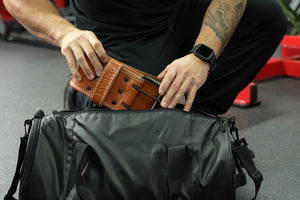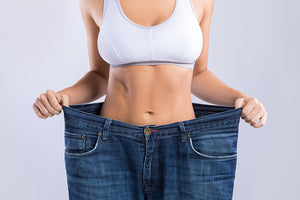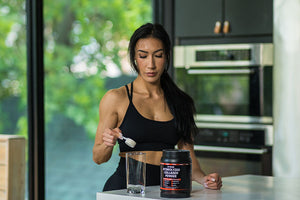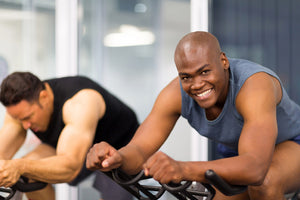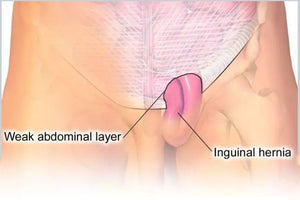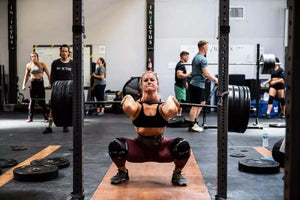It is a fact that the knee is the largest and most complex joint of the human body, connecting the upper and lower legs together. It permits the leg to flex while providing stability to sustain the body's weight. The knee joint has bones, tendons, ligaments, and cartilages, all working in sync to make the movements possible.
The legs are one of the most utilized parts of our body. Be it walking, running, swimming, climbing, or jumping, the legs are constantly in use, making the knees prone to injuries and pain.
Anyone can experience knee pain at some point in their life, which can aggravate if you are obese or have arthritis. Plus, if you are an athlete or fitness enthusiast, you are more likely to suffer from knee issues, particularly knee pain during exercise and training.
According to an article, patellofemoral pain syndrome, also called runner’s knee, is athletes' most prevalent orthopedic issue. According to Cleveland Clinic, 18 million people consult a doctor regarding knee pains annually caused by different issues.
It means you cannot ignore knee pain, thinking of it as a small thing because it may linger for years if left untreated. It leads to other issues, and ultimately you may end up having difficulty even walking or doing regular activities. However, you can improve knee pain and other knee-related issues with medication, using knee sleeves, and exercise.
Related Article: 16 Tips to Reduce Stress & Improve Your Joint Comfort During Workout
What are the Reasons Behind Knee Pain?
There are multiple reasons or factors behind knee pains. Some of them are physical, while others are genetic or metabolic. The following are the five common reasons for knee pain:
Trauma
There are three primary knee ligaments: anterior cruciate ligament (ACL), medial collateral ligament (MCL), and posterior cruciate ligament (PCL). Ligament injuries are common among athletes. The ACL can be injured by a quick twisting motion or change in direction. It is one of the most common causes of knee pain and injury. The PCL is commonly injured by direct trauma to the area, such as an automobile accident or a football tackle, whereas direct hits to the knee can cause MCL damage.
Knee pain due to overworking or overstretching a tendon can also occur due to knee trauma. Knee discomfort can be caused by inflammation, tendinitis, or ruptures. Tendon injuries can be caused by actions that use the tendons, such as running, jumping, and lifting heavy objects.
Surgery is frequently required to heal a badly damaged tendon. However, you can use a hard support splint to keep the knee fixed during the healing process in less difficult situations.
Connective Tissue Disorders
Many connective tissue disorders are the cause of knee pain and swelling, and Rheumatoid arthritis (RA) is the biggest one. RA is an autoimmune inflammatory disorder that affects joints. The body’s immune system targets and attacks joint tissues instead of the malicious elements in the body in RA. RA and other connective tissue illnesses damage the lining of the joints, unlike degenerative tissue disorders. As a result, the knee joints expand painfully.
If left untreated, RA can cause bone degradation and possibly joint deformity. Even if the discomfort is limited to the knee, RA can cause damage to other parts of the body.
Degenerative Tissue Disorders
Degenerative tissue disorders can be a factor behind knee issues, such as pain, swelling, and injuries. Osteoarthritis is one of the major degenerative tissue orders. Degeneration of adjacent tissues and cartilage of the knees occurs in osteoarthritis. It can cause joint dysfunction, stiffness, and pain.
Aging is also amongst the most common causes of degenerative disorders. According to a study, it affects ten percent of males and thirteen percent of women over 60 years of age in the United States.
Although there is no treatment for this degenerative disease, the symptoms can be managed with modest exercise and pain relievers. Severe damage may necessitate joint replacement or other surgical procedures. An X-ray will be ordered first to determine the extent of the injury and the best course of treatment.
Metabolic Problems
Metabolic problems and other diseases can affect multiple body parts including the knees. Gout is one of the most common metabolic diseases that can affect your knee. It is caused by the accumulation of uric acid crystals in the joints and is highly painful. It produces swelling and inflammation in the knee and a reduction in range of motion.
There is a similar situation called pseudogout. It is often mistaken for gout because it causes calcium-containing crystals to form in the joint fluid, causing knee swelling. Gout and pseudogout are generally treated in the same way.
Infection
Many bacterial infections can cause knee problems while training or practicing on the ground, including cellulitis. It's a dangerous bacterial skin infection that can spread to the knee and surrounding area. If you don’t obtain cellulitis therapy then the infection can emerge even after a little scrape on the knee, which can potentially spread to other parts of the body, such as lymph nodes and the bloodstream.
Septic arthritis, a type of infection that causes swelling, discomfort, and redness in the knee joints, is also possible. You may feel a slight fever in this. Septic arthritis treatment is easy and successful if caught early, but leaving the infection untreated might result in lasting damage to the knee cartilage.
There are different ways to prevent knee pain. Exercise and medication are the most common ways to do so. Doctors may prescribe different medicines to treat knee pain if it is chronic and needs medical attention. But nobody prefers to be on medications; therefore, exercise is the best way to cure the knee issue.
5 Ways to Improve Knee Pain
Knee pain could cause side-stepping injuries and make you do nothing if it worsens. Exercises can help, but you need to follow a proper plan to improve or cure your knee pain. Thankfully you can improve knee pain if you follow the following 5 ways:
1. Strengthen Your Muscles
As per the American Council on Exercise (ACE), muscular strength is the ability to generate the maximum amount of muscle force when doing a specific exercise. If your muscles are strong and you are physically fit, fewer chances of diseases and pains come your way. So, it's essential to work out your muscles and strengthen them.
2. Do The Right Exercises
It is significant to choose exercises that put less strain on the knees. You can opt for cycling, walking, and swimming. Always walk or exercise on flat surfaces. Choosing exercises that put much strain on the knees can be problematic if you continuously do them for a longer time.
3. Maintain Healthy Weight
To reduce knee joint issues, maintaining a healthy weight is vital. All of the upper body’s weight is on the legs. When you are obese or overweight, it may weaken the knee joints as they are involved in movement besides carrying your weight. There are multiple ways to lose weight, like cardio, strength training, and diet.
Related Article: 7 Effective Weight Loss Tips
4. Warm-Up Before Exercise
Warming up before exercise is a must. It pumps up the muscles and prepares the body for the upcoming activity. Also, it reduces the chance of injury and muscle soreness and pain as it increases the blood flow to muscles. So, it's essential to warm up those leg muscles and keep the knees safe.
5. Avoid High Heels
If you are a female reading this, avoid wearing heels. Wear shoes that give a stable basis for your feet and legs and are specifically designed for your chosen exercise. You must replace your running shoes every 300 to 500 km. After 500 miles of use, other athletic shoes should be replaced.
Exercises for Knee Pain Relief
If you have knee pain because of injury, arthritis, or surgery, gentle stretching and strengthening exercises are worth trying. They make the muscles flexible and easy to move. Before trying any exercise plan or program for knee pain relief, consult a doctor or physical therapist to ensure the exercise you will be doing is safer for you or not. They may suggest some modifications based on your knee condition.
Stretching Exercises
According to the American Academy of Orthopedic Surgeons, leg stretching exercises may improve your motion and increase flexibility in the knee joint. It allows the knee to move much easier and smoother.
Warm up for 5 to 10 minutes before stretching exercises. You can choose stationary bike cycling, walking, or an elliptical machine as your warming up activity.
After warming up, complete the following three stretches and repeat them after strengthening exercises.
Heel and Calf Stretch

- Stand straight facing a wall.
- Put your hands on the wall and take a step back as far as you can comfortably. Both feet should have their toes facing forward, heels flat, and knees bent slightly.
- Hold the stretch for 30 seconds by leaning into it. The stretch in your back leg should be noticeable.
- Repeat with the other leg.
- Do this stretch on each leg twice.
Quadriceps Stretch

- Stand next to a wall with feet shoulder-width apart or use a chair for support.
- Bend one knee such that your foot reaches your glutes.
- Grab your ankle and move it towards your glutes to comfortably reach the glutes.
- Hold that for 30 seconds.
- Change the leg and return to the starting position.
- On each side, repeat 2 times.
Hamstring Stretch

- For this, place a mat to give cushioning under your back.
- Straighten both legs while lying down on the mat. You can also bend both knees, having your feet flat on the floor if you feel comfortable.
- Raise one leg off the ground.
- Pull your knee toward your chest with your hands below your thigh but behind the knee until you feel a little stretch.
- Hold here for 30 seconds.
- Lower the leg and switch.
- On each side, repeat 2 times.
Related Article: The Ultimate Guide to Building Bigger and Stronger Glute Muscles
TRENDING ARTICLES
Strengthening Exercises
According to the American Academy of Orthopedic Surgeons, strengthening exercises help decrease the stress on the knees by targeting the surrounding muscles and strengthening them. Work on quadriceps, glutes, hamstrings, and hip muscles for knee strengthening.
Calf Raises

- Stand straight with your feet shoulder-distance apart. Stand next to a wall, or you can use a chair for support.
- Slowly raise your heel from the ground and stand on your toes.
- Lower your heels to the initial position.
- Do 2-3 sets for 10 repeats.
Half Squat

- Get in a squat position, and your feet shoulder distance apart. Either place your hands on your hips, or you can keep them out in the front.
- With your head straight, look straight. Squat down for about 10 inches. It will be a half squat.
- Hold for a few seconds and stand, pushing through your heels.
- Do 2-3 sets for 10 repeats.
Hamstring Curl

- Stand straight with your feet, having hip distance in between. Stand next to a wall or use a chair for support.
- Raise one foot toward the ceiling, bend your knee, then raise your heel. Keep your upper body motionless and your hips facing forward as you go as far as you can.
- Hold the position for 5-10 seconds.
- Relax and come back to the initial position,
- Do 2-3 sets for 10 repeats.
Leg Extensions

- Adjust the chair and sit down, ensuring your feet are on the ground hip-distance apart.
- Straighten your back.
- Lift your right leg by extending the right knee.
- Return to the initial position.
- Repeat with the other leg.
Straight Leg Raise

- You can use a mat to give cushioning under your back for this workout.
- Lay on your back with one leg bent and the other straight out in front of you.
- Contract your straight leg's quadriceps and steadily elevate it off the floor until it's at the same level as your bent knee.
- 5 seconds at the top, then lower to the starting position
- Do 2-3 sets for 10 repetitions.
The Bottom Line
Knee pain can go a long way if it remains untreated. There are numerous reasons for knee pain, including metabolic issues and trauma, etc. So, you must identify the cause first and then start getting the treatment you need.
However, other ways may help you improve knee pain, such as some essential tips and exercises. Working on knee muscles to increase their strength, maintaining a healthy weight, warming up before exercises, and avoiding high heels improve knee pain.
As far as the exercise is concerned, you can start doing a combination of lower body stretching and strengthening exercises. They help you strengthen your knee muscles and increase your flexibility.
Also, it is crucial to consult a doctor or physical therapist before starting any medication or exercise because every knee pain is different. It is better to seek professional assistance for better results.
Reading List
Article Sources
- Aletaha, Daniel, and Josef S. Smolen. “Diagnosis and Management of Rheumatoid Arthritis: A Review.” JAMA, vol. 320, no. 13, Oct. 2018, pp. 1360–72. Silverchair, https://doi.org/10.1001/jama.2018.13103.
- Nancy Garrick, Deputy Director. “Gout.” National Institute of Arthritis and Musculoskeletal and Skin Diseases, 12 Apr. 2017, https://www.niams.nih.gov/health-topics/gout.
- Naraghi, Ali M., and Lawrence M. White. “Imaging of Athletic Injuries of Knee Ligaments and Menisci: Sports Imaging Series.” Radiology, vol. 281, no. 1, Oct. 2016, pp. 23–40. pubs.rsna.org (Atypon), https://doi.org/10.1148/radiol.2016152320.
- “Osteoarthritis.” National Institute on Aging, https://www.nia.nih.gov/health/osteoarthritis. Accessed 23 May 2022.
- Vora, Molly, et al. “Patellofemoral Pain Syndrome in Female Athletes: A Review of Diagnoses, Etiology and Treatment Options.” Orthopedic Reviews, vol. 9, no. 4, Feb. 2018, p. 7281. PubMed Central, https://doi.org/10.4081/or.2017.7281.
- Zhang, Yuqing, and Joanne M. Jordan. “Epidemiology of Osteoarthritis.” Clinics in Geriatric Medicine, vol. 26, no. 3, Aug. 2010, pp. 355–69. PubMed Central, https://doi.org/10.1016/j.cger.2010.03.001.



